The Definitive Book of Body Language (53 page)
Read The Definitive Book of Body Language Online
Authors: Barbara Pease,Allan Pease

When two people are thinking alike or both working on a task together, this position often occurs. We found that
55
percent of people chose this position as the most cooperative, or intuitively took it when asked to work jointly with another person.
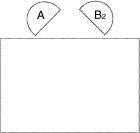
The Cooperative Position
It is one of the best positions for presenting your case and having it accepted because it allows good eye contact and the opportunity for mirroring. The trick is, however, for B to be able to move into this position without A feeling as if his territory has been invaded. This is also a successful position to take when a third party is introduced into the negotiation by B. Say, for example, that a salesperson was having a second interview with a client and the salesperson introduces a technical expert. The following strategy will work well:
The technical expert is seated at position C opposite customer A. The salesperson sits at either position B2 (Cooperative) or B1 (Corner). This allows the salesperson to be “on the client's side” and to ask the technician questions on behalf of the client. This position is known as “siding with the opposition.”
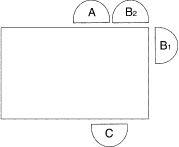
Introducing a third person
In this arrangement, competitors face each other, just like Western gunslingers. Sitting across the table from a person can create a defensive, competitive atmosphere and can lead to each party taking a firm stand on his point of view because the table becomes a solid barrier between both parties.
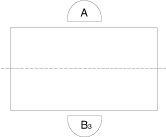
Competitive/Defensive Position
In business scenarios,
56
percent of respondents saw this as a competitive position, but in social situations, such as a restaurant, 35 percent saw it as conversational. It's the most commonly observed restaurant sitting position on the dating scene, but this is mainly because waiters seat people at tables this way. It works with a couple in a restaurant because it allows good eye contact while subtly highlighting gender differences by being “opposite.” In a work environment, however, this position is taken by people who are either competing with each other or one is reprimanding the other. It can also be used by A to establish a superior/subordinate role when it's used on A's territory.
We found that, in business scenarios, people speak in shorter sentences from the Competitive/Defensive Position, can recall less of what was said, and are more likely to argue.
A. G. White conducted an experiment in doctors' offices that showed that the presence or absence of a desk had a significant effect on whether a patient was at ease or not. Only 10 percent of patients were perceived to be at ease when the doctor's desk was present and the doctor sat behind it. This figure increased to
55
percent when the desk was absent. We conducted an experiment
(Pease & Pease, 1990) where we asked 244 senior managers and 127 lower/middle managers to sketch the furniture arrangement they preferred to have in their offices when relocating to a new building. A full 76 percent of the senior managers (185) drew a sketch placing their desks between themselves and their subordinates. Only 50 percent of the lower managers (64) did this, and male managers were twice as likely as females to put the desk between them and others.
The most interesting finding was how other staff members perceived the managers who did not have their desks placed like a barrier. These managers were described by their staff as more fair-minded, more prepared to listen to their ideas without criticism, and less likely to show favoritism to others.
Sitting directly opposite others creates bad vibes.
If B is seeking to persuade A, the Competitive Position reduces the chance of a successful negotiation, unless B is deliberately sitting opposite as part of a preplanned strategy. For example, it may be that A is a manager who has to reprimand employee B, and the Competitive Position can add weight to the reprimand. On the other hand, if B wants to make A feel superior, B can deliberately sit directly opposite A.
Whatever business you're in, if it involves dealing with people you are in the influencing business and your objective should always be to see the other person's point of view, to put him at ease, and to make him feel right about dealing with you; the Competitive Position does not lead to that end. More cooperation will be gained from the Corner and Cooperative Positions than will ever be achieved from the Competitive Position. Conversations are significantly shorter and more pointed in the Competitive Position.
This is taken by people when they don't want to interact with each other. It occurs between strangers in places such as libraries, park benches, or restaurants and is the position we
refer to when we say we are “diametrically opposite” to an idea. To 42 percent of our respondents, the message it conveyed was a lack of interest and it was read by some as showing indifference or hostility This position should be avoided where open discussions between people are your goal.
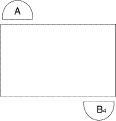
The Independent Position
tells others you don't want
to get involved
As we've said, rectangular tables create a competitive or defensive relationship between people because each person has equal space, equal frontage, and separate edges. It lets everyone take a position on a given subject and allows more direct eye contact across the table. Square tables are ideal for having short, to-the-point conversations or for creating superior or subordinate relationships. Most cooperation comes from the person seated beside you, and the one on the right tends to be more cooperative than the one on the left.
Historically, the person on the right is less likely to be able to successfully stab you with their left hand, hence the “right-hand man” is more favored and others subconsciously credit the right-hand person with having more power than the one on the left side. Most resistance comes from the person seated directly opposite in the “gunslinger” position and, when four people are seated, everyone has someone sitting opposite.
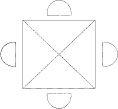
Everyone gets to sit in both the Competitive and Corner Positions on a square table
King Arthur used the Round Table as an attempt to give each of his knights an equal amount of authority and status. A round table creates an atmosphere of relaxed informality and is ideal for promoting discussion among people who are of equal status, as each person can claim the same amount of table territory The circle itself has become a worldwide symbol of unity and strength and simply sitting in a circle promotes the same effect. Unfortunately, King Arthur was unaware that if the status of one person is higher than the others in the group it completely alters the dynamics of group power. The king held the most power and this meant that the knights seated on either side of him were silently granted the next highest amount of power, the one on his right having more than the one on his left. The power then diminished relative to the distance that each knight was seated away from the king.
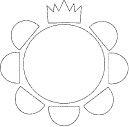
A high-status person at a round table distorts the power distribution
The knight seated directly opposite King Arthur was, in effect, in the Competitive/Defensive Position and was likely to be the one to give the most trouble. Sixty-eight percent of respondents saw the person sitting directly opposite them on a round table as the one most likely to argue or be competitive. Fifty-six percent also said that sitting opposite could be used to show non-involvement or lack of interest, as in a public library. When sitting directly beside another person, 71 percent said they were either having a friendly conversation or cooperating.
Many of today's business executives use rectangular, square, and round tables. The rectangular desk, which is usually the work desk, is used for business activity, brief conversations,
reprimands, and so on. The round table, often a coffee table with wraparound seating or lower chairs, is used to create an informal relaxed atmosphere or to persuade. It is also often found in families that practice democracy or don't have a dominant parent. Square tables belong in a canteen.